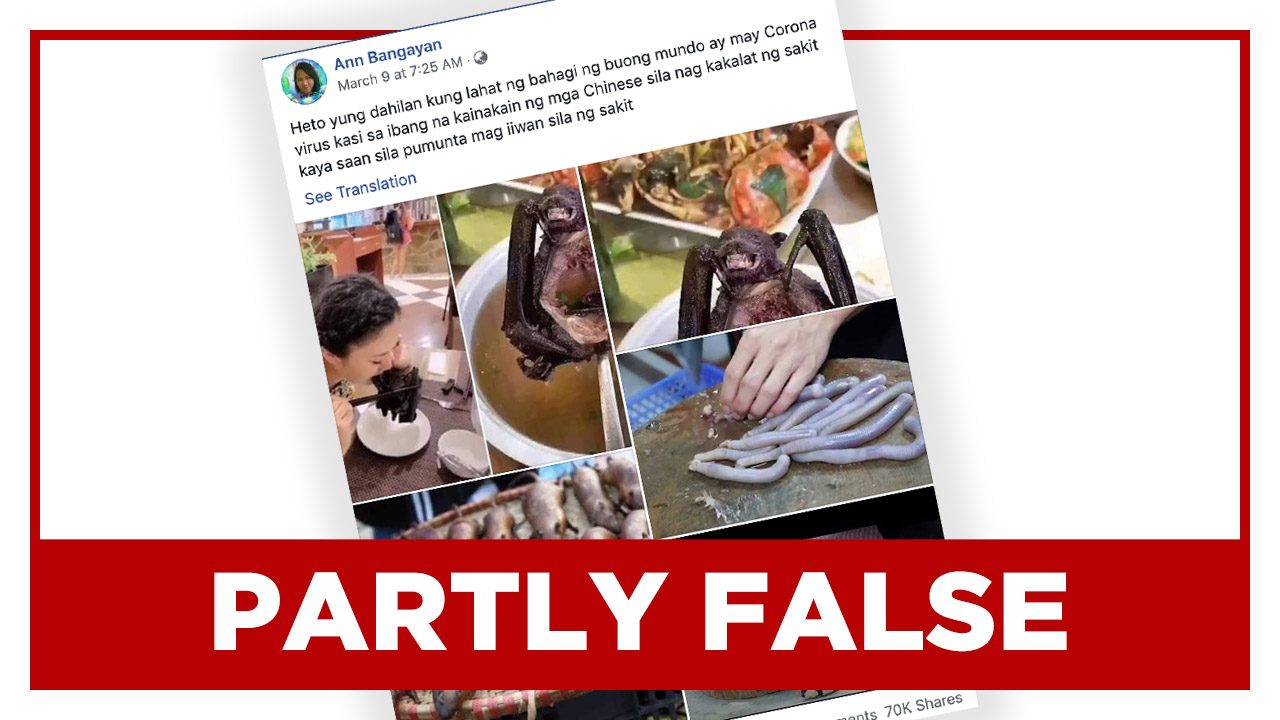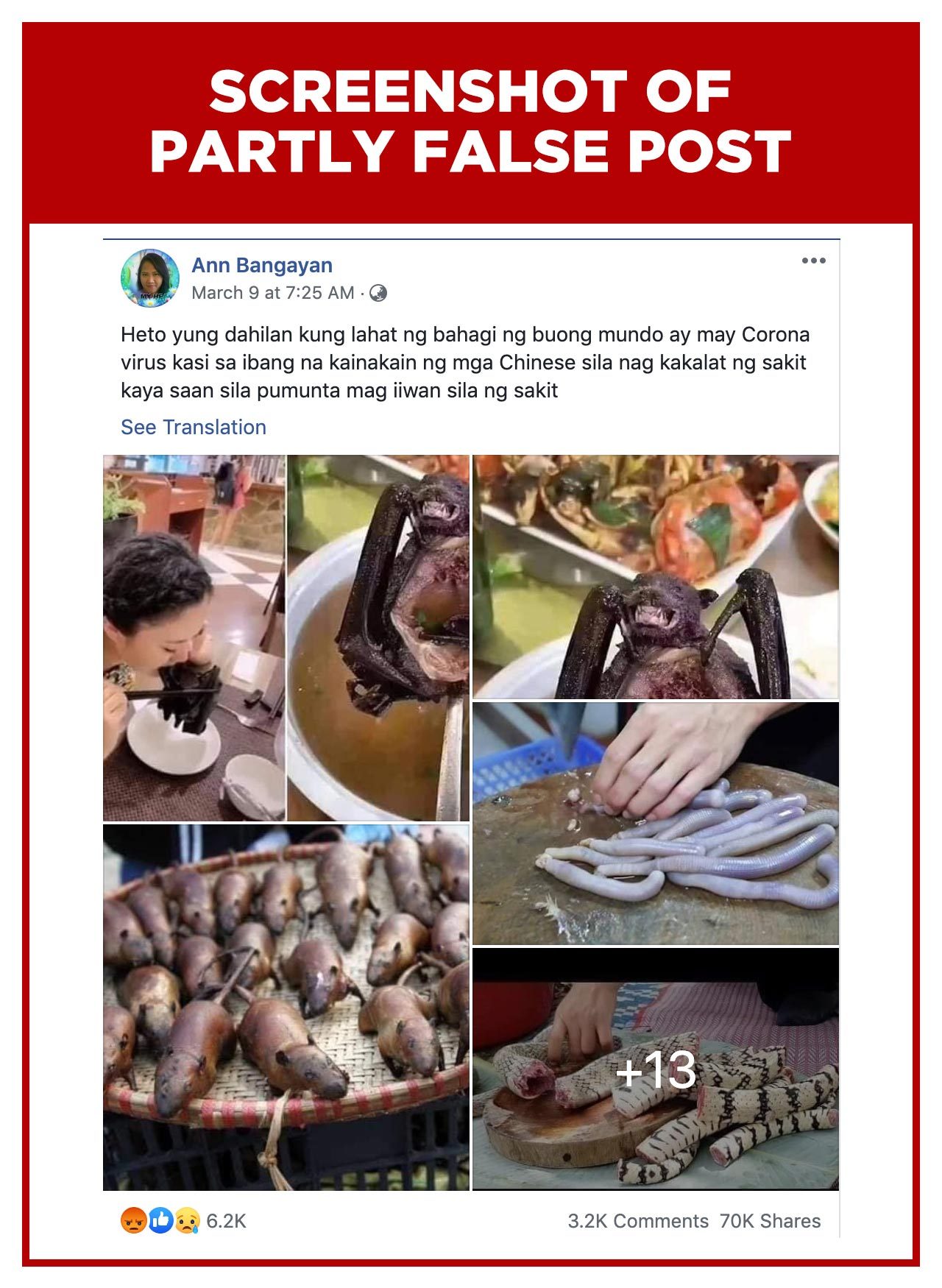SUMMARY
This is AI generated summarization, which may have errors. For context, always refer to the full article.

Claim: Chinese eating exotic animals is the cause of the 2019 novel coronavirus, according to a Facebook post by user Ann Bangayan.
“Heto yung dahilan kung lahat ng bahagi ng buong mundo ay may Corona virus kasi sa ibang na kainakain ng mga chanise (Chinese) sila nag kakalat ng sakit kaya saan sila pumunta mag iiwan sila ng sakit,” Bangayan posted on March 9.
(This is the reason why coronavirus is in all parts of the world. Because the Chinese eat these, they spread diseases and everywhere they go they leave infections.)
Bangayan’s post included 17 photos of exotic animals prepared as food in her post, including bats, rats, worms, snakes, insects, crabs, axolotls, scorpions, crocodiles, maggots, caterpillars, spiders, and centipedes.

Facebook Claim Check, the social media platform’s monitoring tool for potentially dubious posts, flagged Bangayan’s post for fact checking. At least 34 users reported the post to Facebook for containing false information.
As of writing, the post had been shared over 70,000 times, had over 6,200 reactions, and 3,200 comments.
Rating: PARTLY FALSE
The facts: Some of the photos in the viral Facebook post were not taken in China.
Using reverse image search, Rappler found that some of the photos included in the viral post were taken in other countries.
The woman having bat soup was a Chinese blogger, but a fact check article by The France 24 Observers said there is no proof that she ate it in China. The French fact checker further said that the bat soup in the woman’s video looked like it was from Palau, where it is a delicacy.
Though some of the photos showing wild animals sold as street food were really from China, the photo of rats was taken at the market of Canh Nau village, west of Hanoi; the chopped snakes photo was taken in Cambodia, and the image of axolotls came from Japan.
Moreover, as of Friday, March 13, there are still not enough studies available that confirm the source of the 2019 novel coronavirus. There are available studies that suggest bats, snakes, and/or pangolins are potential hosts of the virus, but further research is needed to confirm this. The manner that the virus is transmitted to humans is also still unknown.
“Coronaviruses are a large family of viruses that are common in animals. Occasionally, people get infected with these viruses which may then spread to other people. For example, SARS-CoV was associated with civet cats, while MERS-CoV is transmitted by dromedary camels. Possible animal sources of COVID-19 have not yet been confirmed,” WHO said in their FAQs.
Still, measures against consuming animals have been imposed to prevent the spread of the virus.
As a general precaution, WHO suggests avoiding direct contact with animals and surfaces with animals on them when visiting live animal markets, as well as ensuring good food safety practices at all times.
China has also banned wildlife trade following the outbreak. – Pauline Macaraeg/Rappler.com
Keep us aware of suspicious Facebook pages, groups, accounts, websites, articles, or photos in your network by contacting us at factcheck@rappler.com. Let us battle disinformation one Fact Check at a time.
More fact checks on COVID-19:
- FALSE: Vatican confirms Pope Francis ‘tested positive’ for coronavirus
- FALSE: ‘Official’ coronavirus face mask released
- FALSE: Cannabis ‘kills coronavirus’
- FALSE: ‘Photo’ of coronavirus-infected corpses in Wuhan
- FALSE: Video of Filipinos ‘eating bats in Wuhan, China’
- FALSE: Novel coronavirus ‘will not spread in PH’ due to high temperature, humidity
- FALSE: Natural ginger ale a ‘cure for coronavirus’
- FALSE: Media didn’t report novel coronavirus has low fatality rate
- FALSE: Novel coronavirus ‘can be cured by garlic’
- FALSE: Coronavirus can be ‘eliminated’ by high temperatures
- FALSE: Novel coronavirus a ‘type of rabies’
- FALSE: ‘Positive’ coronavirus case in Laguna hospital
- FALSE: ‘Patient tested positive’ for 2019-nCoV in Makati Medical Center
- FALSE: Chinese patient in Alabang clinic, hospital tested ‘positive’ for coronavirus
- FACT CHECK: Misinformation on novel coronavirus that spreads online
Add a comment
How does this make you feel?
There are no comments yet. Add your comment to start the conversation.